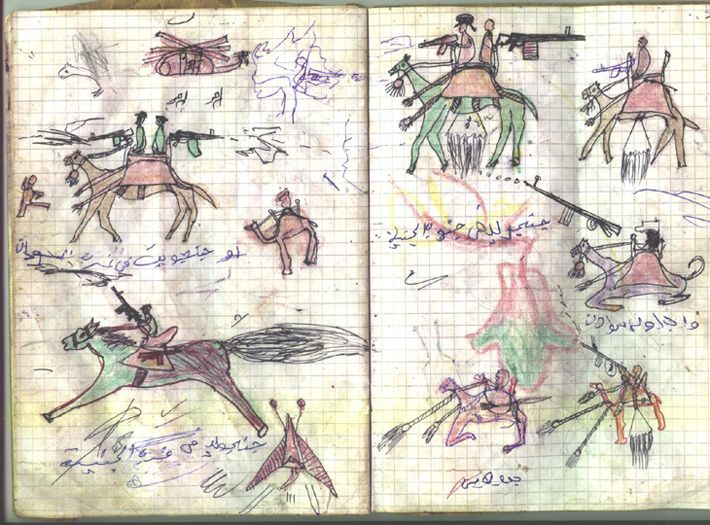Human Rights Watch offentliggør en række børnetegninger fra Darfur, som skal fremlægges for the Internationale Criminal Court i sager om forbrydelser imod menneskeheden.
Tegningen ovenover er fra den britiske avis Independent og er tegnet af en dreng fra Darfur. Den viser ifølge the Independent sudanesiske tropper angribe en landsby.
En del af de over 500 tegninger, der er sendt til the ICC er lavet i skolen andre er lavet i forbindelse med interviews HRW medarbejdere har haft med børn i området. Det gælder f.eks. tegningen herunder, som HRW lader følge af denne tekst:
Abd al-Rahman, Age 13
“I am looking at the sheep in the wadi [riverbed, or
oasis]. I see Janjaweed coming—quickly, on horses and camels, with
Kalashnikovs—shooting and yelling, ‘kill the slaves, kill the blacks.’ They
killed many of the men with the animals. I saw people falling on the ground
and bleeding. They chased after children. Some of us were taken, some we
didn’t see again. All our animals were taken: camels, cows, sheep, and goats.
Then the planes came and bombed the village.”

Tegningerne taler tydeligt i sig selv. The Independent skriver også om,
hvordan de kan bruges til indsigt i børns psyke og som led i kunstterapi
(art therapy). Det har en terapeutisk funktion, at børnene kan udtrykke i
billeder, hvad de ikke kan sætte ord på:
Wherever children are traumatised, giving them a pen and paper and asking
them to draw what they feel is one of the best forms of therapy. It has been
used in every kind of war zone - from abusive families to international
conflicts.
Often it is the only kind. Young children who have witnessed the horror of losing their parents or seen their home destroyed may be too shocked to speak. Unable to express their feelings or find words to describe them, drawing offers a way of pinning down the thoughts racing through their heads. Then they can cope.
The picture from Darfur on the front page is dominated by two huge explosions - a graphic illustration of how terrifying the deafening noise and blinding light would be to a child..
"Then they can cope", så kan de klare det. Det er nok en mild overdrivelse, - men de skal jo klare det på en eller anden måde. Generelt siger bladet (2.8.07), at børn kan kondensere indtryk af en hjemlig situation (domestic situation) således:
In a domestic setting, children can condense a whole world of longing into a single drawing. In hospital they will draw themselves shut away, isolated from all the other children outside. Or represented as a tiny figure swamped by hundreds of tubes and drains. "You can tell a lot about how they feel," Ms Doorbar (børnepsykolog, der har arbejdet med traumatiserede børn) said.
Families can find themselves suddenly exposed. One child drew her family showing only her mother and sisters, leaving her father and brothers out. Another child, the natural daughter of foster parents, asked to draw a picture of herself, instead drew a house. When asked why she explained she was the house. "People come here and I have to look after them," she said .